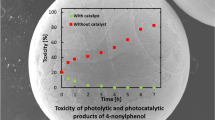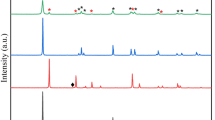Abstract
Photocatalytic degradation of bisphenol A (2,2-bis(4-hydroxyphenyl)propane, BPA), a representative endocrine-disrupting compound, was carried out in the presence of the Ti-MCM-41 mesoporous molecular sieve in this investigation. The degradation rate was strongly dependent on those factors such as the catalyst, catalyst amount, radiation time, and pH value. The photolysis reaction was found to follow the Langmuir–Hinshelwood model. After the photocatalytic treatment, decomposition of BPA rendered five intermediates as follows: 2-methyl-2,3-dihydrobenzofuran, 4-hydroxyacetophenone, 1,1-diethoxyethane, isobutanol, and 3-methylbutanal, which could be the direct evidence supporting our proposal for the degradation mechanism.






Similar content being viewed by others
References
Akpan, U. G., & Hameed, B. H. (2009). Parameters affecting the photocatalytic degradation of dyes using TiO2-based photocatalysts: A review. Journal of Hazardous Materials, 170, 520–529.
Alba, M. D., Luan, Z., & Klinowski, J. (1996). Titanosilicate mesoporous molecular sieve MCM-41: Synthesis and characterization. The Journal of Physical Chemistry, 100, 2178–2182.
Fukahori, S., Ichiura, H., Kitaoka, T., & Tanaka, H. (2003). Capturing of bisphenol A photodecomposition intermediates by composite TiO2–zeolite sheets. Applied Catalysis. B: Environmental, 46, 453–462.
Furhacker, M., Weber, H., & Scharf, S. (2000). Bisphenol A: Emissions from point sources. Chemosphere, 41, 751–756.
Gültekin, I., & Ince, N. H. (2007). Synthetic endocrine disruptors in the environment and water remediation by advanced oxidation processes. Journal of Environmental Management, 85, 816–832.
Horikoshi, S., Kajitani, M., & Serpone, N. (2007). The microwave-/photo-assisted degradation of bisphenol-A in aqueous TiO2 dispersions revisited: Re-assessment of the microwave non-thermal effect. Journal of Photochemistry and Photobiology. A: Chemistry, 188, 1–4.
Hu, Y., Nagai, Y., Rahmawaty, D., Wei, C. H., & Anpo, M. (2008). Characteristics of the photocatalytic oxidation of methane into methanol on V-containing MCM-41 catalysts. Catalysis Letters, 124, 80–84.
Ikeda, K., Kawamura, Y., Yamamoto, T., & Iwamoto, M. (2008). Effectiveness of the template-ion exchange method for appearance of catalytic activity of Ni-MCM-41 for the ethene to propene reaction. Catalysis Communications, 9, 106–110.
Ioan, I., Wilson, S., Lundanes, E., & Neculai, A. (2007). Comparison of Fenton and sono-Fenton bisphenol A degradation. Journal of Hazardous Materials, 142, 559–563.
Ismail, A. A., Ibrahim, I. A., Ahmed, M. S., Mohamed, R. M., & El-Shall, H. (2004). Sol–gel synthesis of titania–silica photocatalyst for cyanide photodegradation. Journal of Photochemistry and Photobiology. A: Chemistry, 163, 445–451.
Kim, S. B., & Sung, C. H. (2002). Kinetic study for photocatalytic degradation of volatile organic compounds in air using thin film TiO2 photocatalyst. Applied Catalysis B: Environmental, 35, 305–315.
Li, F. B., Li, X. Z., & Li, X. M. (2007). Heterogeneous photodegradation of bisphenol A with iron oxides and oxalate in aqueous solution. Journal of Colloid and Interface Science, 311, 481–490.
Liu, Y. X., Deng, L., Chen, Y., Wu, F., & Deng, N. S. (2007). Simultaneous photocatalytic reduction of Cr(VI) and oxidation of bisphenol A induced by Fe(III)–OH complexes in water. Journal of Hazardous Materials, 139, 399–402.
Mohamed, R. M., Ismail, A. A., Othman, I., & Ibrahima, I. A. (2005). Preparation of TiO2–ZSM-5 zeolite for photodegradation of EDTA. Journal of Molecular Catalysis A: Chemical, 238, 151–157.
Ohko, Y., Ando, I., Niwa, C., Ttsuma, T., Yamamura, T., Nakashima, T., et al. (2001). Degradation of bisphenol A in water by TiO2 photocatalyst. Environmental Science Technology, 35, 2365–2368.
Perego, C., Angelis, A., Carati, A., Flego, C., Millini, R., Rizzo, C., et al. (2006). Amorphous aluminosilicate catalysts for hydroxyalkylation of aniline and phenol. Applied Catalysis. A: General, 307, 128–136.
Phanikrishna Sharma, M. V., Durga Kumari, V., & Subrahmanyam, M. (2008). Photocatalytic degradation of isoproturon herbicide over TiO2/Al-MCM-41 composite systems using solar light. Chemosphere, 72, 644–651.
Puma, G. L., Bono, A., Krishnaiah, D., & Collin, J. G. (2008). Preparation of titanium dioxide photocatalyst loaded onto activated carbon support using chemical vapor deposition: A review paper. Journal of Hazardous Materials, 157, 209–219.
Rincon, A. G., & Pulgarin, C. (2004). Effect of pH, inorganic ions, organic matter and H2O2 on E. coli K12 photocatalytic inactivation by TiO2: Implications in solar water disinfection. Applied Catalysis B: Environmental, 51, 283–302.
Sadjadi, M. S., Farhadyar, N., & Zare, K. (2009). Synthesis of nanosize MCM-41 loaded with TiO2 and study of its photocatalytic activity. Superlattices and Microstructures, 46, 266–271.
Scully, C., Collins, G., & O'Flaherty, V. (2006). Anaerobic biological treatment of phenol at 9.5–15°C in an expanded granular sludge bed (EGSB)-based bioreactor. Water Research, 40, 3737–3744.
Shen, S. H., & Guo, L. J. (2007). Hydrothermal synthesis, characterization, and photocatalytic performances of Cr incorporated, and Cr and Ti co-incorporated MCM-41 as visible light photocatalysts for water splitting. Catalysis Today, 129, 414–420.
Tang, W. Z., & Huang, C. P. (1995). Photocatalyzed oxidation pathways of 2,4-dichlorophenol by CdS in basic and acidic aqueous solutions. Water Research, 29, 745–756.
Tsumura, R., Higashimoto, S., Matsuoka, M., Yamashita, H., Che, M., & Anpo, M. (2004). Investigations on the photoluminescence properties of Mo-MCM-41 and the photocatalytic decomposition of NO in the presence of CO. Catalysis Letters, 68, 101–103.
Wang, Y. C., Liu, Q. K., & Zhao, Q. X. (2006). Biological treatment principles of bisphenol A by activated sludge. Journal of East China University of Science and Technology (Natural Science Edition), 32, 1072–1075.
Wang, X. L., Wu, G. D., Li, J. P., Wei, W., & Sun, Y. H. (2007). Selective oxidation of benzyl alcohol catalyzed by Cr (salen) complexes immobilized on MCM-41. Journal of Molecular Catalysis. A: Chemical, 276, 86–94.
Xie, Y. B., & Li, X. Z. (2006). Degradation of bisphenol A in aqueous solution by H2O2-assisted photoelectrocatalytic oxidation. Journal of Hazardous Materials, 138, 526–533.
Xu, B., Gao, N. Y., Rui, M., Wang, H., & Wu, H. H. (2007). Degradation of endocrine disruptor bisphenol A in drinking water by ozone oxidation. Frontiers of Environmental Science & Engineering in China, 1, 294–299.
Zeng, G. M., Zhang, C., Huang, G. H., Yu, J., Wang, Q., Li, J. B., et al. (2006). Adsorption behavior of bisphenol A on sediments in Xiangjiang River, central-south China. Chemosphere, 65, 1490–1499.
Zhang, W., Zou, L., & Wang, L. (2009). Photocatalytic TiO2/adsorbent nanocomposites prepared via wet chemical impregnation for wastewater treatment: A review. Applied Catalysis A: General, 371, 1–9.
Acknowledgments
The study is supported by the Natural Science Foundation of Shanghai, China (grant no. 10ZR1421300).
Author information
Authors and Affiliations
Corresponding author
Electronic Supplementary Material
Below is the link to the electronic supplementary material.
Figure S1
Initial reaction rate of BPA photocatalytic degradation versus initial BPA concentration (pH 7; catalyst amount, 0.1 g/L) (GIF 76 kb)
Figure S2
GC–MS total ion chromatograms of BPA degradation product (GIF 249 kb)
Figure S3
Mass spectra of five authentic compounds (GIF 509 kb)
Rights and permissions
About this article
Cite this article
Tao, H., Hao, S., Chang, F. et al. Photodegradation of Bisphenol A by Titana Nanoparticles in Mesoporous MCM-41. Water Air Soil Pollut 214, 491–498 (2011). https://doi.org/10.1007/s11270-010-0440-y
Received:
Accepted:
Published:
Issue Date:
DOI: https://doi.org/10.1007/s11270-010-0440-y




